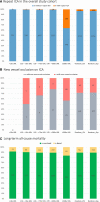High-sensitivity cardiac troponin I after coronary artery bypass grafting for post-operative decision-making
- PMID: 35165695
- PMCID: PMC9246661
- DOI: 10.1093/eurheartj/ehab918
High-sensitivity cardiac troponin I after coronary artery bypass grafting for post-operative decision-making
Abstract
Aims: Current troponin cut-offs suggested for the post-operative workup of patients following coronary artery bypass graft (CABG) surgery are based on studies using non-high-sensitive troponin assays or are arbitrarily chosen. We aimed to identify an optimal cut-off and timing for a proprietary high-sensitivity cardiac troponin I (hs-cTnI) assay to facilitate post-operative clinical decision-making.
Methods and results: We performed a retrospective analysis of all patients undergoing elective isolated CABG at our centre between January 2013 and May 2019. Of 4684 consecutive patients, 161 patients (3.48%) underwent invasive coronary angiography after surgery, of whom 86 patients (53.4%) underwent repeat revascularization. We found an optimal cut-off value for peak hs-cTnI of >13 000 ng/L [>500× the upper reference limit (URL)] to be significantly associated with repeat revascularization within 48 h after surgery, which was internally validated through random repeated sampling with 1000 iterations. The same cut-off also predicted 30-day major adverse cardiovascular events and all-cause mortality after a median follow-up of 3.1 years, which was validated in an external cohort. A decision tree analysis of serial hs-cTnI measurements showed no added benefit of hs-cTnI measurements in patients with electrocardiographic or echocardiographic abnormalities or haemodynamic instability. Likewise, early post-operative hs-cTnI elevations had a low yield for clinical decision-making and only later elevations (at 12-16 h post-operatively) using a threshold of 8000 ng/L (307× URL) were significantly associated with repeat revascularization with an area under the curve of 0.92 (95% confidence interval 0.88-0.95).
Conclusion: Our data suggest that for hs-cTnI, higher cut-offs than currently recommended should be used in the post-operative management of patients following CABG.
Keywords: Coronary artery bypass grafting; High-sensitivity cardiac troponin; Invasive coronary angiography; Post-operative myocardial infarction.
© The Author(s) 2022. Published by Oxford University Press on behalf of European Society of Cardiology.
Figures






Comment in
-
Cardiac troponin elevation after coronary artery bypass graft: improving risk stratification.Eur Heart J. 2023 Jan 7;44(2):162. doi: 10.1093/eurheartj/ehac537. Eur Heart J. 2023. PMID: 36263771 No abstract available.
-
Troponin for risk stratification after CABG: just one piece of the puzzle.Eur Heart J. 2023 Jan 7;44(2):163-164. doi: 10.1093/eurheartj/ehac539. Eur Heart J. 2023. PMID: 36263800 No abstract available.
References
-
- Thielmann M, Sharma V, Al-Attar N, Bulluck H, Bisleri G, Bunge JJH, et al. ESC Joint Working Groups on Cardiovascular Surgery and the Cellular Biology of the Heart Position Paper: perioperative myocardial injury and infarction in patients undergoing coronary artery bypass graft surgery. Eur Heart J 2017;38:2392–2411. - PMC - PubMed
-
- Thygesen K, Alpert JS, Jaffe AS, Chaitman BR, Bax JJ, Morrow DA, et al. ESC Scientific Document Group. Fourth universal definition of myocardial infarction (2018). Eur Heart J 2019;40:237–269. - PubMed
-
- Moussa ID, Klein LW, Shah B, Mehran R, Mack MJ, Brilakis ES, et al. Consideration of a new definition of clinically relevant myocardial infarction after coronary revascularization: an expert consensus document from the Society for Cardiovascular Angiography and Interventions (SCAI). J Am Coll Cardiol 2013;62:1563–1570. - PMC - PubMed
-
- Garcia-Garcia HM, McFadden EP, Farb A, Mehran R, Stone GW, Spertus J, et al. Standardized end point definitions for coronary intervention trials: the academic research consortium-2 consensus document. Circulation 2018;137:2635–2650. - PubMed
-
- Rautaharju PM, Surawicz B, Gettes LS, Bailey JJ, Childers R, Deal BJ, et al. AHA/ACCF/HRS recommendations for the standardization and interpretation of the electrocardiogram: part V: electrocardiogram changes associated with cardiac chamber hypertrophy: a scientific statement from the American Heart Association Electrocardiography and Arrhythmias Committee, Council on Clinical Cardiology; the American College of Cardiology Foundation; and the Heart Rhythm Society. Endorsed by the International Society for Computerized Electrocardiology. J Am Coll Cardiol 2009;53:982–1002. - PubMed
Publication types
MeSH terms
Substances
LinkOut - more resources
Full Text Sources
Medical
Research Materials
Miscellaneous

